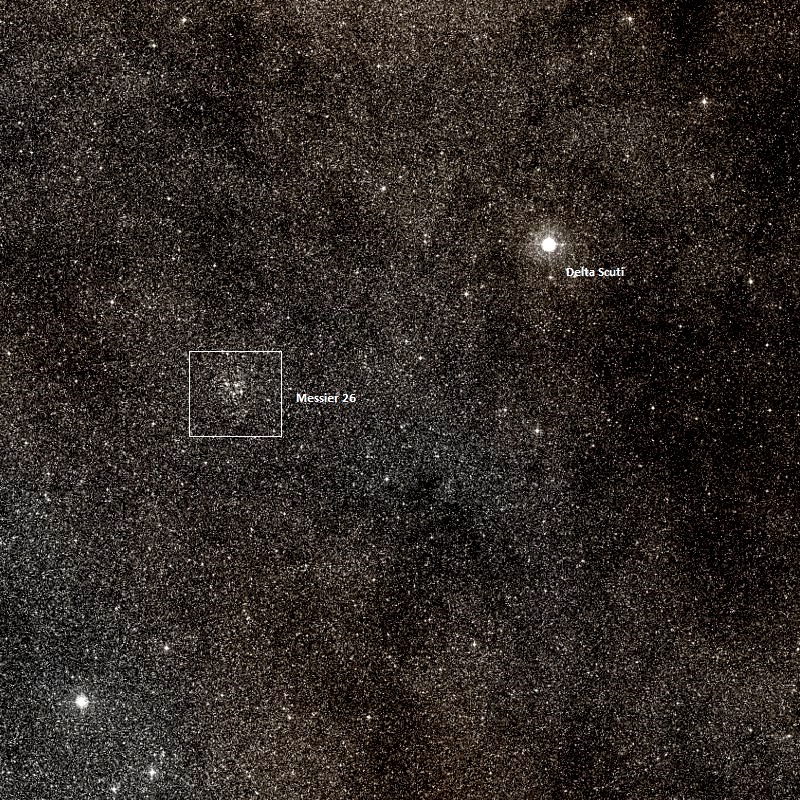Welcome back to Messier Monday! In our ongoing tribute to the great Tammy Plotner, we take a look at Messier 26 open star cluster. Enjoy!
Back in the 18th century, famed French astronomer Charles Messier noted the presence of several "nebulous objects" in the night sky. Having originally mistaken them for comets, he began compiling a list of these objects so that others wouldn't make the same mistake. Consisting of 100 objects, the
Messier Catalog
would come to be viewed by posterity as a major milestone in the study of Deep Space Objects.
One of these objects is Messier 26, an open star cluster located about 5,000 light years from the Earth in the direction of the
Scutum Constellation
. While somewhat faint compared to other objects that share its section of the sky, this star field remains a source of mystery to astronomers, thanks to what appears to be a low-density star field at its nucleus.
Description:
When this cloud of stars formed some 89 million years ago, it was probably far more compact than today's size of a 22 light year span. At a happy distance of about 5,000 light years from our solar system, we can't quite see into the nucleus to determine just how dense it may actually be because of an obscuring cloud of interstellar matter.
[caption id="attachment_131832" align="aligncenter" width="580"]
Image of the Messier 26 Open Star Cluster. Credit: Wikisky
[/caption]
However, we do know a little bit about the stars contained within it. As astronomer James Cuffey suggested in a paper titled
"The Galactic Clusters NGC 6649 and NGC 6694",
which appeared in July 1940 issue of
The Astrophysical Journal:
However boring a field of stars may look upon first encounter, studies are important to our understanding how our galaxy evolved and the timeline incurred. As Kayla Young of the Manhasset Science Research team said:
[caption id="attachment_131831" align="aligncenter" width="580"]
The M26 Open Star Cluster. Credit: NOAO/AURA/NSF
[/caption]
History of Observation:
Messier 26 was first observed by Charles Messier himself on June 20th, 1764. As he wrote of the discovery at the time:
Later, Bode would report a few stars with nebulosity - a field that simply wouldn't resolve to his telescope. William Herschel would spare it but only a brief glance, saying: "A cluster of scattered stars, not rich." While John Herschel would later go on to class it with its NGC designation, it was Admiral Smyth who would most aptly describe M26 for the true galactic cluster we know it to be. As he wrote upon viewing it in April of 1835:
[caption id="attachment_131830" align="aligncenter" width="521"]
The location of Messier 26 within the Scutum Constellation. Credit: IAU/Sky & Telescope magazine (Roger Sinnott & Rick Fienberg)
[/caption]
Locating Messier 26:
Finding Messier 26 in binoculars is easy as far as location goes - but not so easy distinguishing it from the starfield. Begin with the constellation of
Aquila
and its brightest star - Alpha. As you move southwest, count the stars down the Eagle's back. When you reach three you are at the boundary of the constellation of Scutum. While maps make Scutum's stars appear easy to find, they really aren't.
The next most easily distinguished star in the line in Alpha Scutii. Aim your binoculars or finderscope there and you'll see northern Epsilon and southern Delta to the east. Messier 26 is slightly southeast of Delta and will appear as a slight compression in the starfield, and you will be able to resolve a few individual stars to larger ones. Using a finderscope, it will appear as a very vague brightening - perhaps not seen at all depending on your finder's aperture.
In even a small telescope, however, you'll be pleased with what you see! Medium magnification will light up this 8th magnitude galactic star cluster and mid-sized instruments will fully resolve it. Power up! See how many stars you can - and can't - resolve in this dusty, curtained, distant beauty!
And here are the quick facts to help you on your way!
- Object Name
-
Messier 26
- Alternative Designations
-
M26, NGC 6694
- Object Type
-
Open Galactic Star Cluster
- Constellation
-
Scutum
- Right Ascension
-
18 : 45.2 (h:m)
- Declination
-
-09 : 24 (deg:m)
- Distance
-
5.0 (kly)
- Visual Brightness
-
8.0 (mag)
- Apparent Dimension
-
15.0 (arc min)
We have written many interesting articles about Messier Objects here at Universe Today. Here's Tammy Plotner's
Introduction to the Messier Objects
, ,
M1 – The Crab Nebula
,
M8 – The Lagoon Nebula
, and David Dickison's articles on the
2013
and
2014
Messier Marathons.
Be to sure to check out our complete
Messier Catalog
. And for more information, check out the
SEDS Messier Database
.
Sources:
- *Messier Objects – Messier 26*
- SEDS Messier Database – Messier 26
- *Free Star Charts – M26 Open Star Cluster*
- Wikipedia - Messier 26
 Universe Today
Universe Today
